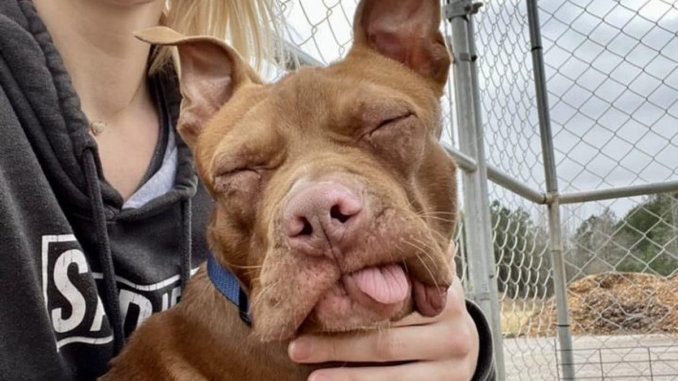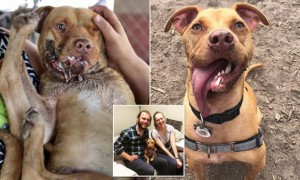
Introduction: A Journey from Abuse to Happiness
It’s heartbreaking to think about the pain that some animals endure at the hands of those they trust. A poor puppy, who suffered unimaginable abuse—having his teeth pulled out by his former owner—is proof of the resilience and strength that animals possess. Though the scars of the past will always be with him, his story is one of recovery, love, and the incredible power of a foster home.
Today, this brave little pup is living his best life in a caring and compassionate foster family, a true testament to the healing abilities of love, patience, and a safe environment. Let’s dive into the journey of how this abused puppy transformed from a broken soul into a happy, healthy dog once again.
The Abuse: A Heartbreaking Beginning
Before he found peace, this puppy’s life was full of pain and suffering. His former owner subjected him to the unimaginable—having his teeth forcibly pulled out. The trauma of such a brutal act left him physically vulnerable and emotionally scarred.
Not only did the puppy endure intense pain, but he also faced severe challenges in everyday activities such as eating. Losing teeth at such a young age left him unable to chew properly, which could have led to long-term health issues had he not been rescued.
It’s a sad reality that many animals, like this puppy, suffer in silence. They rely on their caregivers to protect them, but instead, they experience abuse that leaves them in a fragile state.
The Rescue: A New Hope for the Puppy
After enduring unspeakable cruelty, the puppy was finally rescued. Animal welfare organizations and compassionate individuals stepped in, providing the care and medical attention this poor pup desperately needed. The rescue team immediately took him to a veterinary clinic, where they assessed his condition.
The puppy received urgent treatment for his physical wounds. Although his teeth were lost, the vet ensured that his remaining health needs were met. This marked the beginning of his new life—a life filled with hope and the promise of recovery.
The Power of Foster Homes: Providing Safety and Healing
While the puppy’s physical health was addressed, his emotional scars would require time and patience. This is where a foster home came into play. Foster homes are essential in the rehabilitation of abused animals. These homes offer a temporary but loving environment where animals can heal and learn to trust again.
This puppy’s foster family provided him with the calm and safety he needed to regain his confidence. They gently introduced him to the concept of love and companionship, showing him that not all humans were capable of harm. The calm environment gave him the time and space to adjust and start healing, one step at a time.
Emotional Healing: Overcoming Fear and Trauma
One of the most challenging aspects of abuse recovery is emotional healing. The puppy, who once flinched at the sight of people, began to trust his foster family. Through patience, kindness, and consistent care, his foster parents helped him move past the fear and anxiety that once controlled him.
Although the scars of his past would never disappear, the puppy learned that he could live a life free from the torment he had endured. Over time, he started to show more affection, wagging his tail, and seeking out cuddles from his foster family. These simple gestures marked the turning point in his emotional recovery, helping him realize that love and care were not things to be feared.
Learning to Play Again: The Joy of Rediscovering Puppyhood
As the puppy grew more comfortable in his new environment, he began to rediscover the joys of puppyhood. Despite his difficult start in life, he showed his playful spirit. His foster home became his playground, where he could explore, play with toys, and interact with other pets.
It was in this safe environment that he learned to be a dog again—running, jumping, and enjoying the simple pleasures that every puppy deserves. Whether chasing after a ball or getting a belly rub, his joyful moments are proof that even after pain, there can still be happiness.
The Physical Recovery: Regaining Health and Strength
In addition to emotional recovery, the puppy also faced challenges with his physical health. Losing teeth at a young age impacted his ability to eat, so his foster parents were careful to provide him with soft food and nutritious meals.
With proper care, his strength began to return. He gained weight and grew more energetic each day. His body, once weak from pain and malnutrition, began to reflect the healing process he was undergoing emotionally as well.
Living His Best Life: A Transformation into a Happy Pup
Now, this resilient puppy is no longer the scared, sick animal that he once was. He is living his best life in his foster home. His transformation is nothing short of incredible.
No longer hindered by fear or physical weakness, he is a joyful, energetic, and loving dog who enjoys all the perks of a happy life. His foster parents describe him as a “sweetheart” who loves to cuddle, play with his doggy siblings, and even greet visitors with a wagging tail.
The Role of Foster Families in Animal Recovery
Foster homes play a crucial role in the journey of many abused animals. These homes provide a loving and supportive environment for pets like this puppy, helping them transition from trauma to a better life. Through foster care, animals can heal both physically and emotionally before they are adopted into permanent homes.
Foster families not only provide shelter, but they also give the love and attention that these animals desperately need. Their efforts are invaluable in ensuring that abused pets can live a fulfilling, happy life.
Adoption: The Next Step in the Puppy’s Journey
While the puppy is thriving in his foster home, the next step is finding him a forever family. Adoption is the ultimate goal for many rescue animals, and for this puppy, the time will soon come to transition from foster care to his permanent home.
Finding a loving adoptive family is essential to his continued happiness and well-being. With his friendly and affectionate personality, there’s no doubt that he will find the perfect family who will continue to provide him with the love and care he deserves.
The Importance of Animal Welfare and Awareness
Stories like this puppy’s highlight the importance of animal welfare and awareness. Animal abuse is still a major issue, and it’s up to all of us to make a difference.
If you’re able, consider adopting or fostering an animal in need. Rescue organizations are always looking for loving homes to care for abandoned or abused pets. Additionally, donations to these organizations can help fund the medical and emotional care that animals like this puppy require.
Conclusion: A Story of Resilience, Love, and Hope
This puppy’s journey is a beautiful reminder that, no matter how difficult the start, there is always hope for a better life. From the painful abuse he endured to his incredible recovery in foster care, this pup’s story proves that love, patience, and care can help animals overcome even the darkest of beginnings.
As he continues to grow stronger, both physically and emotionally, his story serves as an inspiration to us all—proof that even the most broken souls can find healing and happiness.
FAQs:
1. How long does it take for a dog to recover from emotional trauma? The recovery process varies for each dog, but with consistent love and care, emotional healing can take anywhere from a few months to a year. Every dog is different, but patience is key.
2. Can a dog live a happy life without teeth? Yes, dogs can live a happy and healthy life without teeth. They may need a special diet, but they can still enjoy their meals and lead an active life.
3. What should I do if I suspect animal abuse? If you suspect animal abuse, contact your local animal control, rescue organization, or the police immediately. It’s crucial to act quickly to ensure the safety of the animal.
4. How can fostering an animal make a difference? Fostering provides abused or abandoned animals with the love, care, and attention they need to heal. It also helps them become more adoptable, giving them a second chance at a happy life.
5. How can I support rescue organizations? You can support rescue organizations by adopting, fostering, donating, or volunteering. Raising awareness about animal welfare is also a great way to make a difference.
